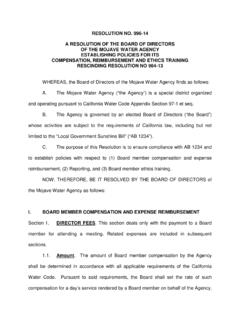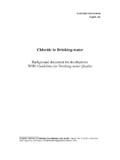Transcription of Mojave Salt and Nutrient Management Plan …
1 Mojave salt and Nutrient Management plan appendices Appendix A: Mojave SNMP Scope of Work Appendix B: Stakeholder Meeting Materials Appendix C: Subregional Synopses Appendix A Mojave salt and Nutrient Management plan Scope of Work CALIFORNIA REGIONAL WATER QUALITY CONTROL BOARD LAHONTAN REGION MEETING OF JANUARY 11 AND 12, 2012 APPLE VALLEY, CALIFORNIA ITEM: 11 SUBJECT: PROPOSED SCOPE OF WORK AND DEVELOPMENT OF A salt AND Nutrient Management plan FOR THE Mojave INTEGRATED REGIONAL WATER Management GROUP, SAN BERNARDINO COUNTY CHRONOLOGY: February 2009 Recycled Water Policy Adopted by State Water Resources Control Board (State Water Board) ISSUE: To provide the Water Board an opportunity to provide input on the content and development of a regional salt and Nutrient Management plan (SNMP) to manage salts and nutrients within the groundwaters of the Mojave watershed (Enclosure 1).
2 The final SNMP will likely be adopted as a Basin plan amendment at a later date. DISCUSSION: The Mojave Water Agency (MWA) was formed in 1959 by an act of the California Legislature and was activated by a vote of the residents in 1960 to manage groundwater resources in the Mojave , El Mirage, and Lucerne Valley basins. The Morongo and Johnson Valley basins were later annexed in 1965. The MWA service area is within the boundaries of two Regional Water Boards, the Lahontan and Colorado River Water Boards. The Mojave and El Mirage basins (collectively referred to as Mojave basin ) are located in the Lahontan Region. The Lucerne Valley, Johnson Valley, and Morongo groundwater basins are located in the Colorado River Region.
3 Since 1994, MWA has been proactive in the development of a comprehensive water resources plan and worked closely with stakeholders to develop an Integrated Regional Water Management plan (IRWMP) in 2004. The IRWMP addresses components of groundwater Management , urban water Management , agricultural water use, environmental habitat protection and restoration, and water quality throughout the MWA service area. In 2009, the California Department of Water Resources (DWR) approved the Mojave IRWM Region as the MWA service area boundary. The Recycled Water Policy, State Water Board Resolution No. 2009-0011 (Enclosure 2), establishes goals to manage a 11-1 Page 2 sustainable water supply through increased use of recycled water, enhanced stormwater Management , and improved water conservation efforts.
4 The Water Boards have determined that regulating individual waste discharges in a groundwater basin may not be effective or efficient at ensuring long-term protection of groundwater resources and its beneficial uses without some overall evaluation of potential salt and Nutrient loading. One of the key elements of the Recycled Water Policy is the development of a SNMP for every groundwater basin within California by 2014. The purpose of the SNMP is to evaluate the potential for salt and Nutrient increases from all sources and to develop a Management plan to protect groundwater from accumulating salts and nutrients at concentrations that would degrade the quality of groundwater and limit its beneficial uses.
5 Waste discharges could then be regulated in a manner consistent with the SNMP. Potential sources of salts and nutrients include naturally occurring salts and minerals in soils and bedrock, irrigation water (which could originate from surface water, groundwater, and/or recycled water), water banking projects, and discharges of waste to land from activities such as agricultural, industrial, commercial, and/or residential. The development of the SNMP is to be driven, controlled, and funded by local stakeholders, such as the Mojave IRWM Group, with participation by the regional water boards. Once developed, a SNMP will provide a roadmap for water agencies to manage salt and Nutrient loading within a basin.
6 Ultimately, the regional water boards will incorporate the various SNMPs into the Basin Plans. To offset the costs of developing and implementing a SNMP, grant funds are available through Proposition 84, which is administered by DWR. The Mojave IRWM Group is in the process of updating its IRWMP and intends to incorporate the SNMP as an appendix to the updated plan . The objectives of the SNMP are: 1) gather available water quality data to evaluate the quality of surface water and groundwater at the watershed and sub-basin level; 2) identify potential sources of salt and nutrients and quantify loads for those sources; 3) determine assimilative capacity of the groundwater based on hydrologic/geologic characteristics and source water quality for individual sub-basins; 4) develop a water quality monitoring and reporting plan that is designed to evaluate and track the long-term impacts to groundwater quality resulting from past, current, and future land uses.
7 5) identify and recommend most appropriate methods and best Management practices for reducing and/or maintaining salt and Nutrient loadings; and 6) demonstrate that implementation of the SMP will satisfy the requirements of the State Antidegradation Policy, State Water Board Resolution No. 68-16 and the Recycled Water Policy. The scope of work for the Mojave SNMP follows draft guidance provided by the State Water Board (Enclosure 3). A timeline for tasks associated with the development of the SNMP is outlined in Enclosure 4. 11-2 Page 3 Lahontan Water Board staff has provided comments to the Mojave IRWM Group on the draft scope of work dated November 2011 (Enclosure 5).
8 Technical comments were made in an effort to clarify the purpose and goals of the SNMP as well as to guide the Mojave IRWM Group toward developing a comprehensive and defensible SNMP based on a reliable dataset. In essence, the intent of the SNMP is to serve as a long-term planning tool. Staff comments included: 1) stakeholder participation is critical to identify potential sources of salts and nutrients, to compile available water quality data, and to encourage successful implementation of the plan ; 2) the model chosen to evaluate assimilative capacity needs to be adaptable and capable of integrating source loading from future projects; 3) the effects of importation of water and transferring recycled water sources between sub-basins should be considered; 4) long-term monitoring should continue until steady state conditions within the basin have been achieved.
9 And 5) identify which agencies are responsible for managing current and future anthropogenic loads and what actions these agencies must take to provide the Water Board with assurances that local entities will manage the groundwater basin using their authorities or by other means to achieve the water quality specified in the plan . Based on the actual conditions over time, planning time scales may need to be adjusted. It is anticipated that the Mojave IRWM Group will submit a revised scope of work incorporating staff comments by December 23, 2011. The Mojave IRWM Group will present its revised scope of work at the Water Board meeting. Water Board staff has solicited comments from the Mojave IRWM Group and interested parties regarding this agenda item.
10 RECOMMENDA- TION: This is an informational item only. Water Board members may provide direction and input on the proposed scope of work and content of the SNMP for the groundwaters within the Mojave basin. ENCLOSURE: ITEM: BATES NUMBER: 1 Proposed Scope of Work, November 2011 (Revised Scope of Work to be submitted to Water Board members prior to the Board meeting) 11-7 2 Recycled Water Policy 11-13 3 Suggested Elements of a SNMP (State Water Board Draft Guidance) 11-33 4 Timeline of Tasks 11-39 5 Staff Comments on Draft Scope of Work, December 2011 11-43 11-3 ENCLOSURE 1 11-5 This page is blank intentionally. 11-6 November 2011 Enclosure 1 DRAFT SCOPE OF WORK salt / Nutrient Management plan Prepared by the Mojave IRWM Group PURPOSE To develop a regional salt / Nutrient Management plan (SMP) for the Mojave Water Agency Integrated Regional Water Management (IRWM) Region that will identify and manage, on a regional basis, salts and nutrients from sources within the region, for the purpose of maintaining regional water quality objectives and supporting beneficial uses.

